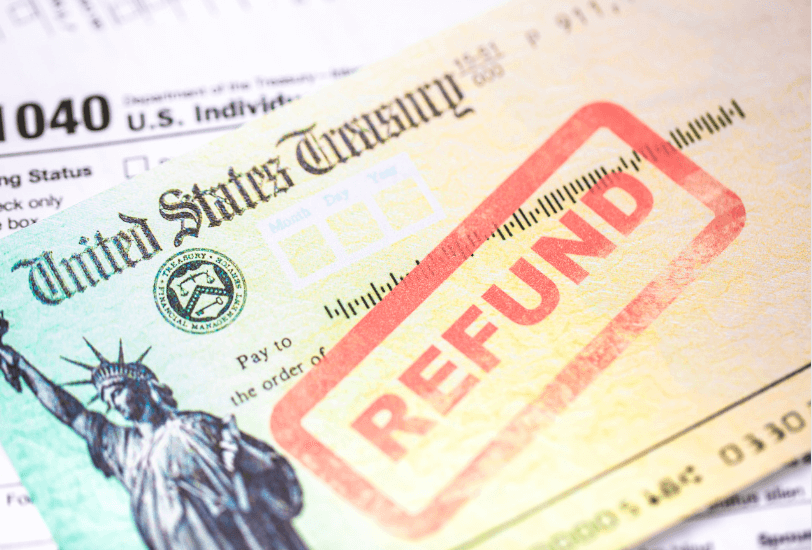- January 29, 2024
- Posted by: Gavtax
- Category: real estate investors

Did you know that in 2022, more than 237.8 million Americans received a tax refund? But is this a common scenario for real estate investors too? Today, we’re going to explain the tax refunds and understand if investors are part of this statistic. Let’s get started!
Real estate investors can reduce taxes and potentially be eligible for refunds through several strategies:
1. SOLO 401k contributions:
Real estate investors can contribute pre-tax dollars to a SOLO 401k, a retirement plan designed for self-employed individuals with no employees other than a spouse. This reduces their taxable income.
Contributions are made directly from earnings, reducing the investor’s taxable income for the year. The contribution limit is higher compared to traditional 401ks, allowing for significant tax savings.
If an investor earns $100,000 and contributes $19,500 to their SOLO 401k, their taxable income reduces to $80,500. If they’re in a 25% tax bracket, this contribution can save $4,875 in taxes for the year.
2. Opportunity Zone Investments:
Opportunity Zone Investments involve investing in economically distressed areas designated as Opportunity Zones. The main benefit is the potential deferral, reduction, or elimination of capital gains taxes.
Investors can defer taxes on any prior gains invested in a Qualified Opportunity Fund (QOF) until the earliest of the date the Opportunity Zone investment is sold or December 31, 2026. If the investment is held for longer than 5 years, there’s a 10% exclusion of the deferred gain; if held for more than 7 years, the exclusion rises to 15%. If the investment in the Opportunity Zone is held for at least 10 years, investors are eligible for an increase in basis equal to the fair market value of the investment on the date it is sold, potentially eliminating capital gains taxes on the appreciation of the Opportunity Zone investment.
If an investor realizes a $100,000 capital gain and invests it into a QOF, and holds it for 10 years, they could potentially avoid paying capital gains tax on the appreciation of that investment. If the QOF investment grows to $150,000, the $50,000 gain would be tax-free.
3. Tracking Repairs and Improvements:
Tracking repairs and improvements is crucial for real estate investors to accurately categorize expenses and capitalize costs.
Distinguish between repairs (immediate, necessary maintenance of property, fully deductible in the year incurred) and improvements (enhancements that add value or extend property life, capitalized and depreciated over time).
Maintain detailed records and receipts for all work done on properties. This helps in correctly classifying each expense for tax purposes.
If an investor spends $5,000 on repairing a damaged roof (an immediate expense), it’s fully deductible in the same tax year. If they spend $20,000 on a kitchen remodel (an improvement), this cost is capitalized and depreciated, say over 5 years, allowing a $4,000 depreciation deduction each year.
4. Investing in an Index Life Insurance:
Index Life Insurance involves investing in a policy where cash value growth is linked to a stock market index, like the S&P 500.
The policy provides life insurance coverage and an investment component. The cash value can grow tax-deferred based on the index’s performance, with a cap on gains and a floor on losses.
Choose an Indexed Universal Life Insurance policy, pay premiums, and allocate a portion to the index-linked account.
If an investor pays an annual premium of $10,000, and the index returns 7% in a year, the cash value could increase by $700 (minus fees). If the index drops, the floor (e.g., 0%) ensures the cash value doesn’t decrease.
5. Doing a 1031 exchange:
A 1031 exchange allows real estate investors to defer capital gains taxes by reinvesting the proceeds from a property sale into a new property.
After selling a property, the investor must identify a replacement property within 45 days and complete the purchase within 180 days. The proceeds from the sale must be held by a qualified intermediary and used to acquire the replacement property.
If an investor sells a property for $500,000 that was originally purchased for $300,000, they would face a capital gain of $200,000. By reinvesting this $500,000 into a new property through a 1031 exchange, they defer paying capital gains tax on the $200,000 gain.
That wraps up our video on strategies like SOLO 401k contributions, Opportunity Zone investments, tracking repairs and improvements, Index Life Insurance, and 1031 Exchanges for real estate investors to reduce taxes and be eligible for refunds.
For a personalized approach, don’t hesitate to book a free consultation call with us. Find the link in the video description below.
If you found this information helpful, please like, subscribe, share, and leave a comment with your thoughts or questions. Your engagement helps us create more content like this. Thanks for watching!
